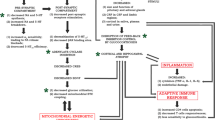Objective. Much attention in biological psychiatry in recent decades had been paid to functional and structural anomalies of the brain in groups at high risk of developing endogenous psychoses. Linkages between neurophysiological and neuroimaging parameters have been studied in cases of ultra-high risk of developing endogenous psychoses. The present report presents some results from the initial stage of this investigation. Materials and methods. A total of 56 patients aged 17–25 years with nonpsychotic mental disorders were studied. The control group consisted of 20 mentally healthy patients of comparable age and gender. Neurophysiological studies addressed measures characterizing the ability of the brain to “regulate” the volume of incoming information (sensory gating). Localizing proton MR spectroscopy was used simultaneously to determine some measures of metabolic processes in the brain (the glutamate/glutamine index and levels of N-acetylaspartate and choline-containing substances in the dorsolateral prefrontal cortex and thalamus of the left and right hemispheres and the genu and splenium of the corpus callosum. Results and conclusions. The results suggest impairment to the sensory filter in patients of the ultra-high risk group for developing endogenous psychoses; there was no correlation with the metabolic processes studied. These latter were normal or became normal during treatment.
Similar content being viewed by others
References
M. Davis and S. File, Habituation, Sensitization, and Behavior, Academic Press, New York (1984).
Z. I. Storozheva, A. V. Kirenskaya, I. E. Lazarev, et al., “Studies of the prestimulus modification of the acoustic startle reaction in healthy subjects and schizophrenia patients,” Zh. Nevrol. Psikhiat., 111, No. 2, 72 (2011).
N. R. Swerdlow, M. Weber, Y. Qu, et al., “Realistic expectations of prepulse inhibition in translational models for schizophrenia research,” Psychopharmacology, 199, No. 3, 331–338 (2008).
N. Boutrus, H. Nasrallah, R. Leighty, et al., “Auditory evoked potentials, clinical vs research applications,” Psychiat. Res., 69, 183–195 (2010).
M. J. van Tricht, D. H. Nieman, J. H. Koelman, et al., “Auditory ERP components before and after transition to a first psychotic episode,” Biol. Psychol.,” 87, No. 3, 350–357 (2011).
M. H. Hsieh, J. C. Shan, W. L. Huang, et al., “Auditory event-related potential of subjects with suspected pre-psychotic state and first-episode psychosis,” 140, No. 1, 243–249 (2012).
A. Brockhaus-Dumke, F. Schultze-Lutter, R. Muelle, et al., “Sensory gating in schizophrenia: P50 and N100 gating in antipsychotic-free subjects at risk, first-episode, and chronic patients,” Biol. Psychiatry, 64, No. 5, 376–384 (2008).
P. Tibbo, S. E. Purdon, A. Valiakalayil, et al., “Elevated 3T proton MRS glutamate levels associated with poor Continuous Performance Test (CPT-0X) scores and genetic risk for schizophrenia,” Schizophr. Res., 99, No. 1, 218–224 (2008).
C. de la Fuente-Sandoval, P. Leon-Ortiz, R. Favila, et al., “Higher levels of glutamate in the associative-striatum of subjects with prodromal symptoms of schizophrenia and patients with first-episode psychosis,” Neuropsychopharmacology, 36, No. 9, 1781–1791 (2011).
S. J. Wood, C. Pantelis, D. Velakoulis, et al., “Neuroanatomical abnormalities before and after onset of psychosis: a cross-sectional and longitudinal MRI comparison,” Lancet, 361, No. 9354, 281–288 (2003).
N. Tandon, N. R. Bolo, K. Sanghavi, et al., “Brain metabolite alterations in young adults at familial high risk for schizophrenia using proton magnetic resonance spectroscopy,” Schizophr. Res., 148, No. 1, 59–66 (2013).
Y. Shirayama, T. Obata, D. Matsuzawa, et al., “Specific metabolites in the medial prefrontal cortex are associated with the neurocognitive deficits in schizophrenia: a preliminary study,” Neuroimage, 49, No. 3, 2783–2790 (2010).
S. Brugger, J. M. Davis, S. Leucht, and J. M. Stone, “Proton magnetic resonance spectroscopy and illness stage in schizophrenia – a systematic review and meta-analysis,” Biol. Psychiatry, 69, No. 5, 495–503 (2011).
K. Aydin, A. Ucok, and J. Guler, “Altered metabolic integrity of corpus callosum among individuals at ultra high risk of schizophrenia and first-episode patients,” Biol. Psychiatry, 64, No. 9, 750–757 (2008).
T. J. Miller, T. H. McGlashan, S. W. Woods, et al., “Symptom assessment in schizophrenic prodromal states,” Psych. Quart., 70, No. 4, 273–287 (1999).
T. H. McGlashan, T. J. Miller, J. L. Rosen, et al., “Prodromal assessment with the structured interview for prodromal syndromes and the scale of prodromal symptoms: predictive validity, interrater reliability, and training to reliability,” Schizophr. Bull., 29, No. 4, 703 (2003).
N. N. Boutrus, B. H. Jansen, and L. Hu, “Auditory evoked potential variability in healthy and schizophrenia subjects,” Clin. Neurophys., 121, No. 8, 1233–1239 (2010).
N. N. Boutros, O. Korzyukov, B. Jansen, et al., “Sensory gating deficits during the mid-latency phase of information processing in medicated schizophrenia patients,” Psych. Res., 126, No. 3, 203–215 (2004).
N. N. Boutros, A. Brockhaus-Dumke, K. Gjini, et al., “Sensorygating deficit of the N100 mid-latency auditory evoked potential in medicated schizophrenia patients,” Schizophr. Res., 113, No. 2, 339–346 (2009).
I. Uhl, P. Mavrogiorgou, C. Norra, et al., “H-MR spectroscopy in ultra-high risk and first episode stages of schizophrenia,” J. Psychiatr. Res., 45, No. 9, 1135–1139 (2011).
P. Ohrmann, “Neurochemie der Schizophrenie: Möglichkeiten der Magnetresonanzspektroskopie,” in: Universitätskolloquien zur Schizophrenie, Steinkopff (2004), pp. 125–130.
Author information
Authors and Affiliations
Corresponding author
Additional information
Translated from Zhurnal Nevrologii i Psikhiatrii imeni S. S. Korsakova, Vol. 115, No. 1, Iss I, pp. 24–29, January, 2015.
Rights and permissions
About this article
Cite this article
Shendyapina, M.V., Omel’chenko, M.A., Lebedeva, I.S. et al. Information Processing and Some Indicators of Brain Metabolism in Patients at Ultra-High Risk of Developing Endogenous Psychosis. Neurosci Behav Physi 46, 523–528 (2016). https://doi.org/10.1007/s11055-016-0271-4
Published:
Issue Date:
DOI: https://doi.org/10.1007/s11055-016-0271-4




